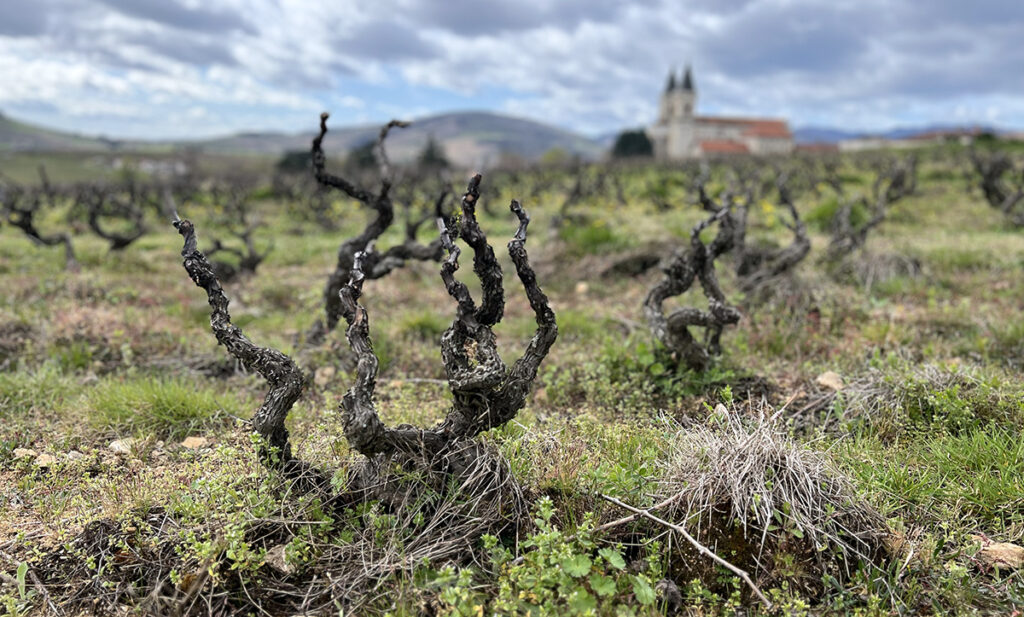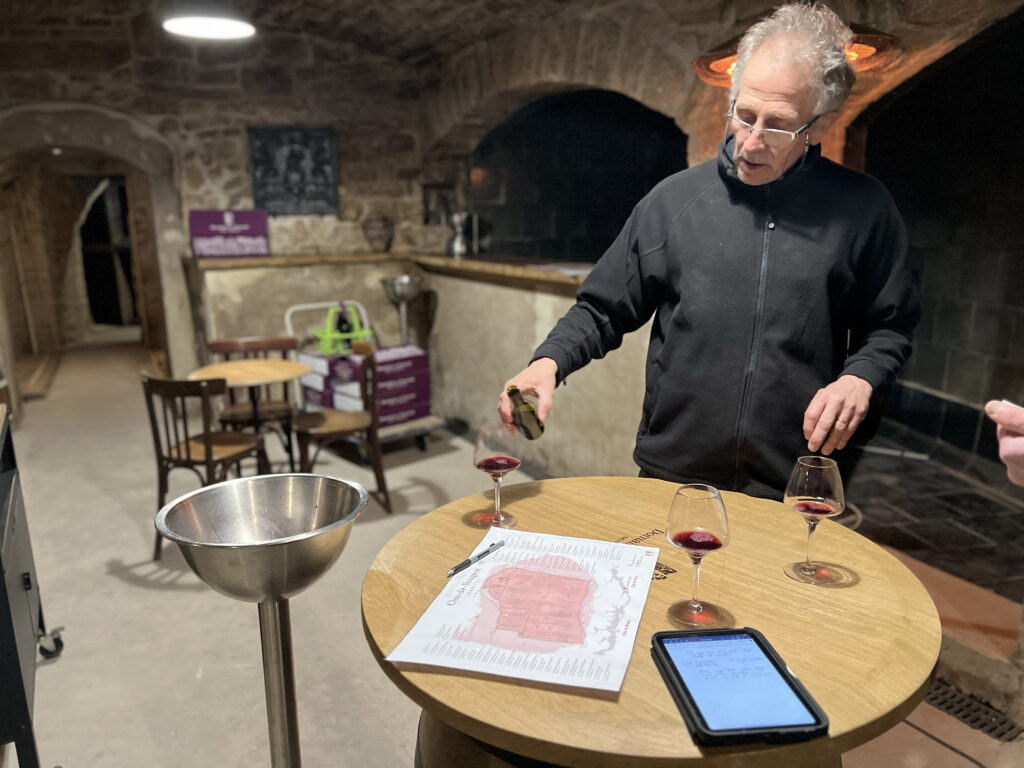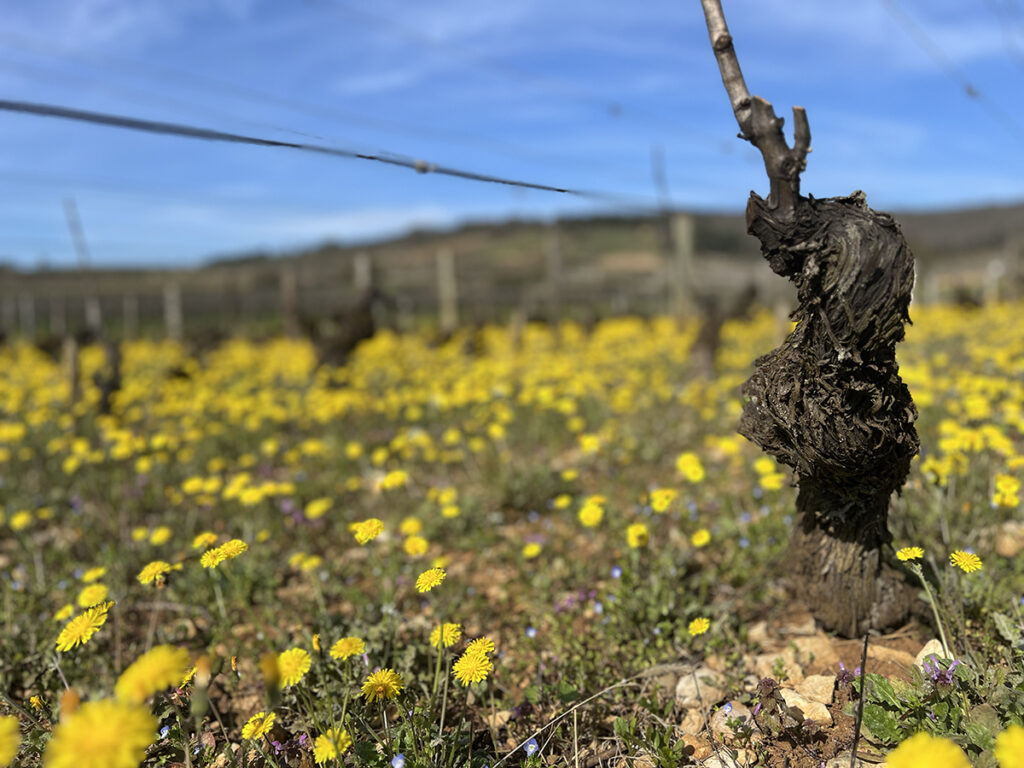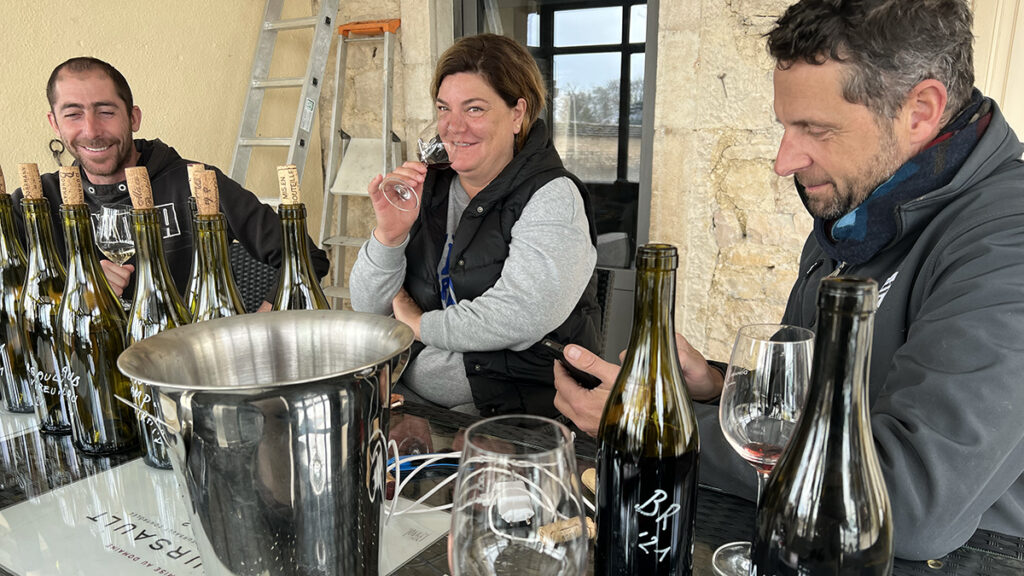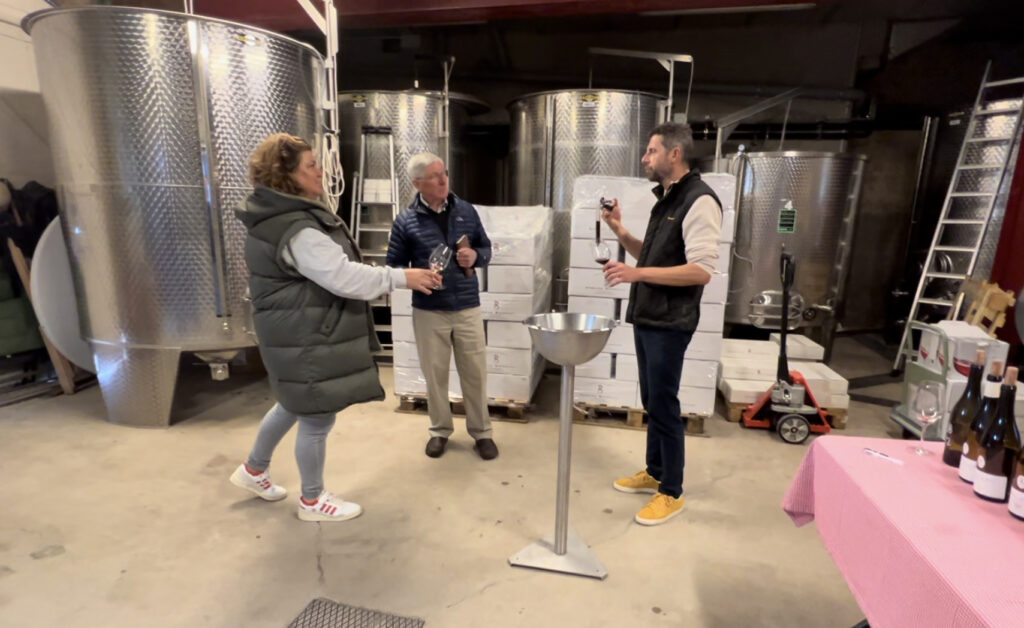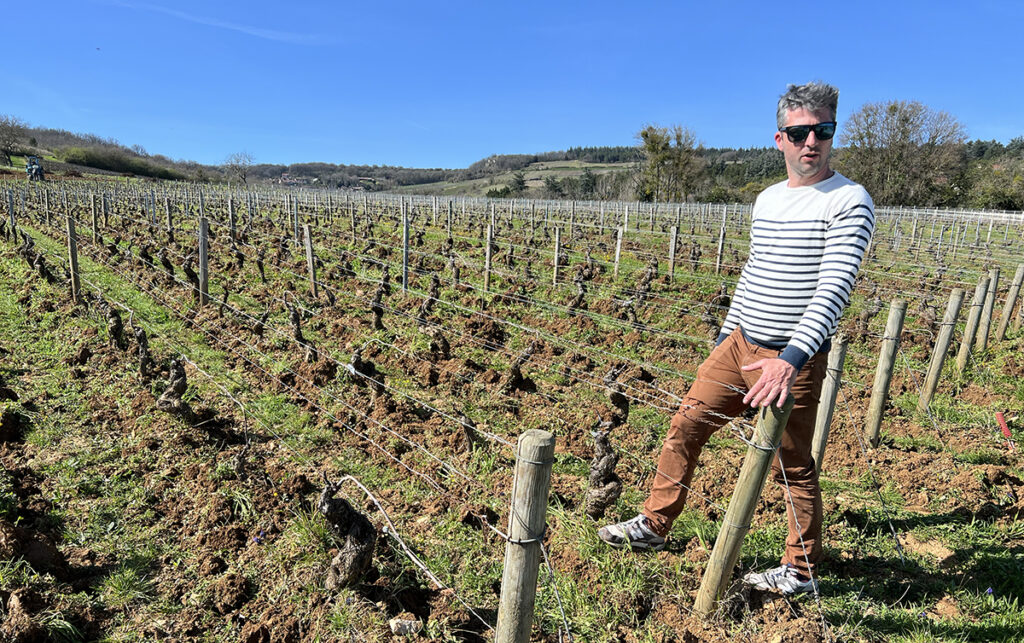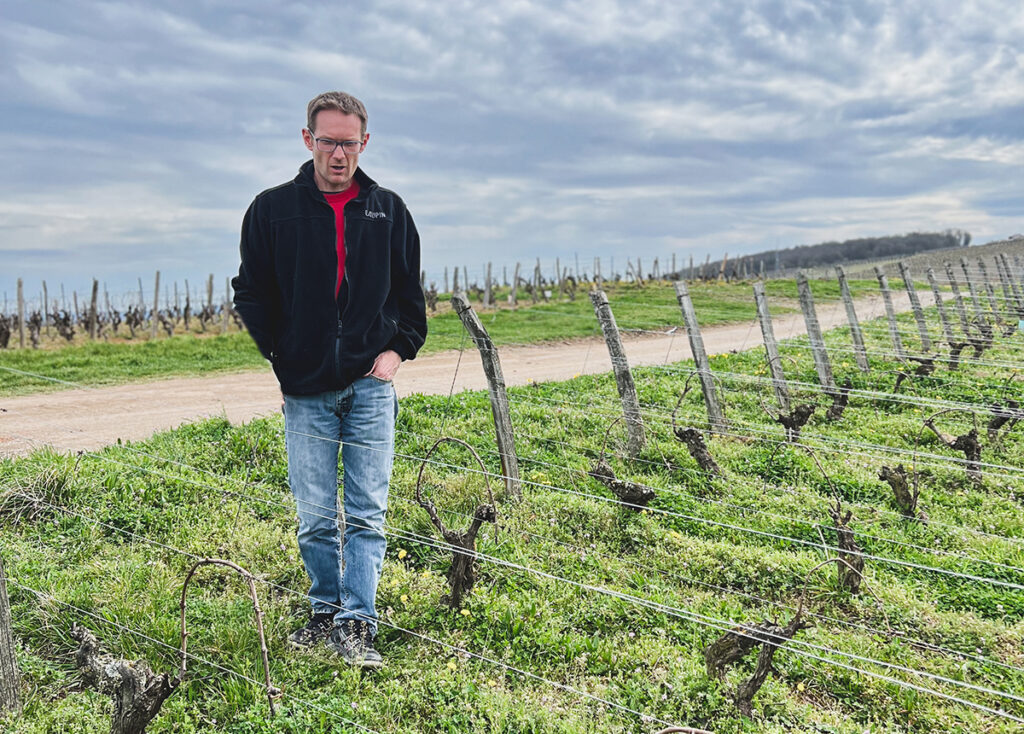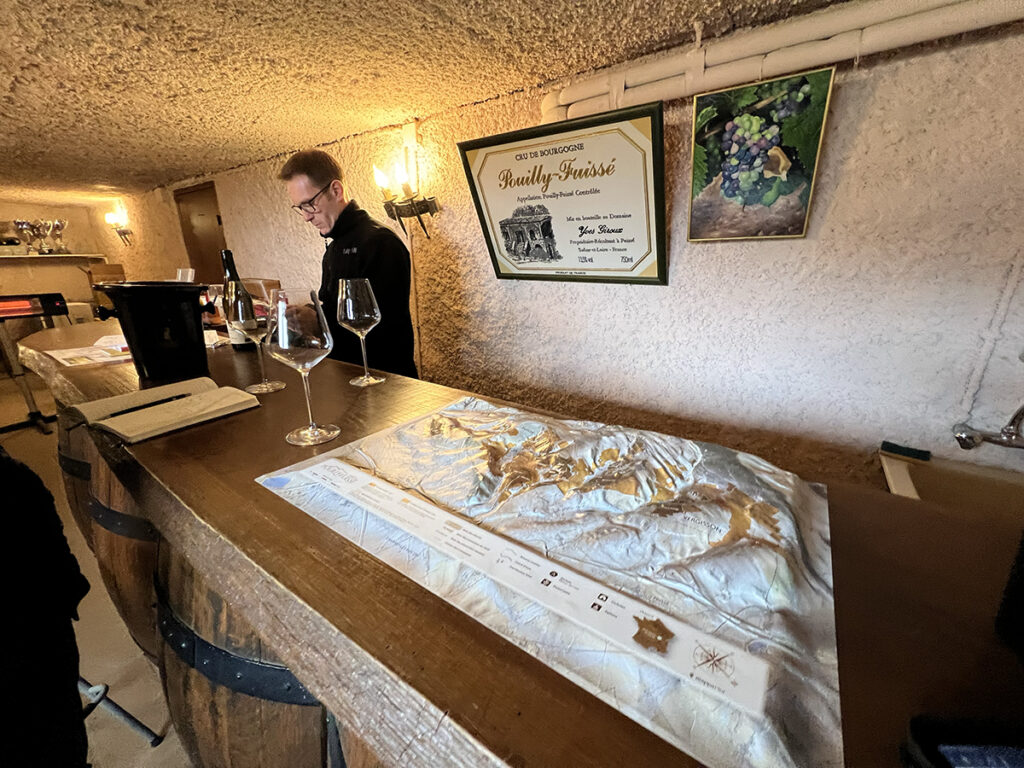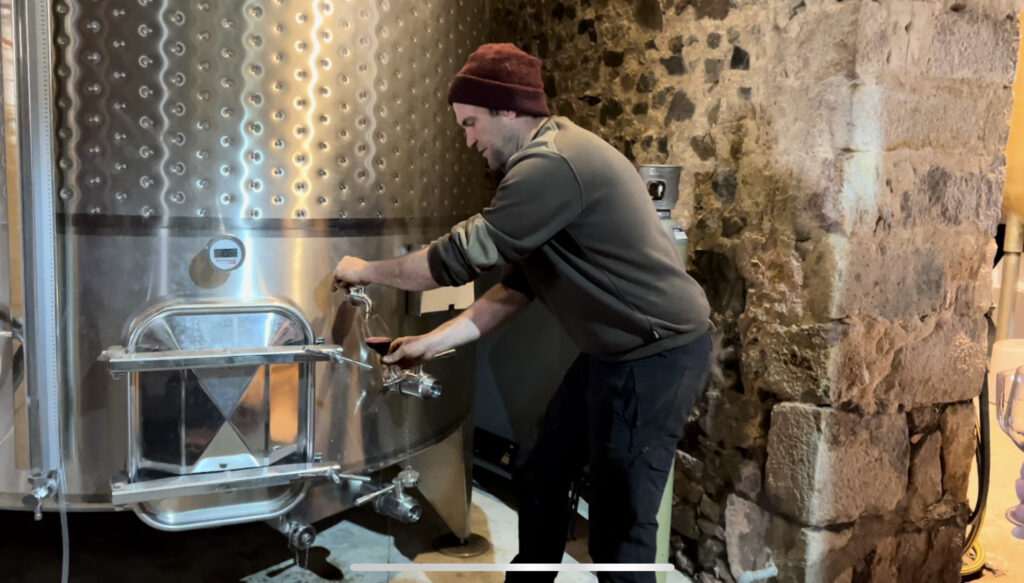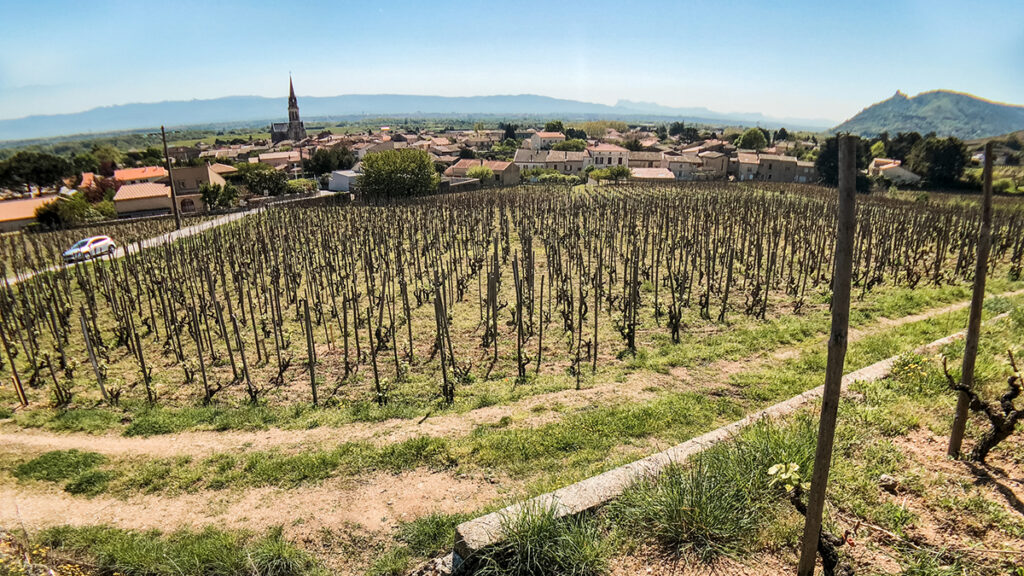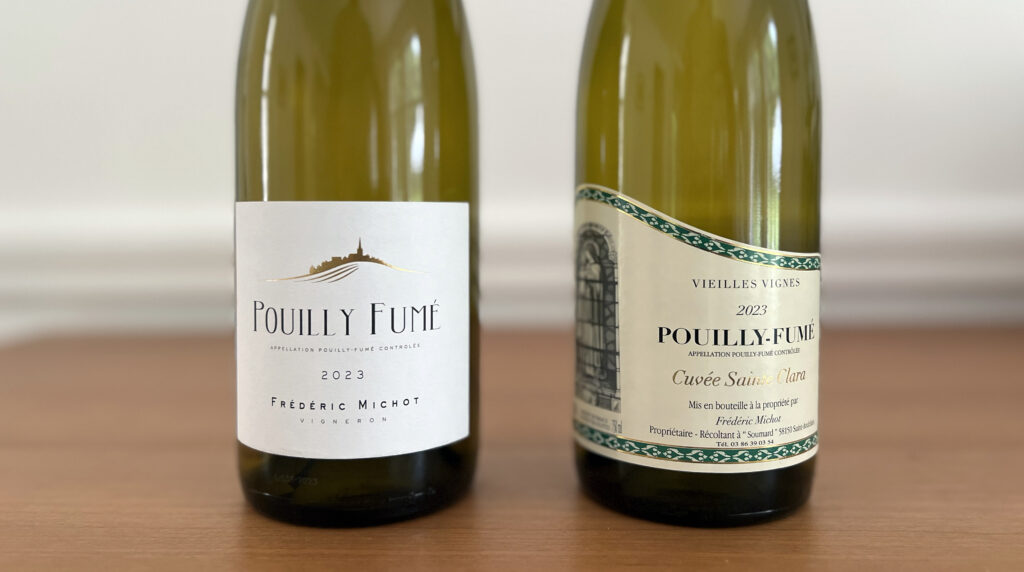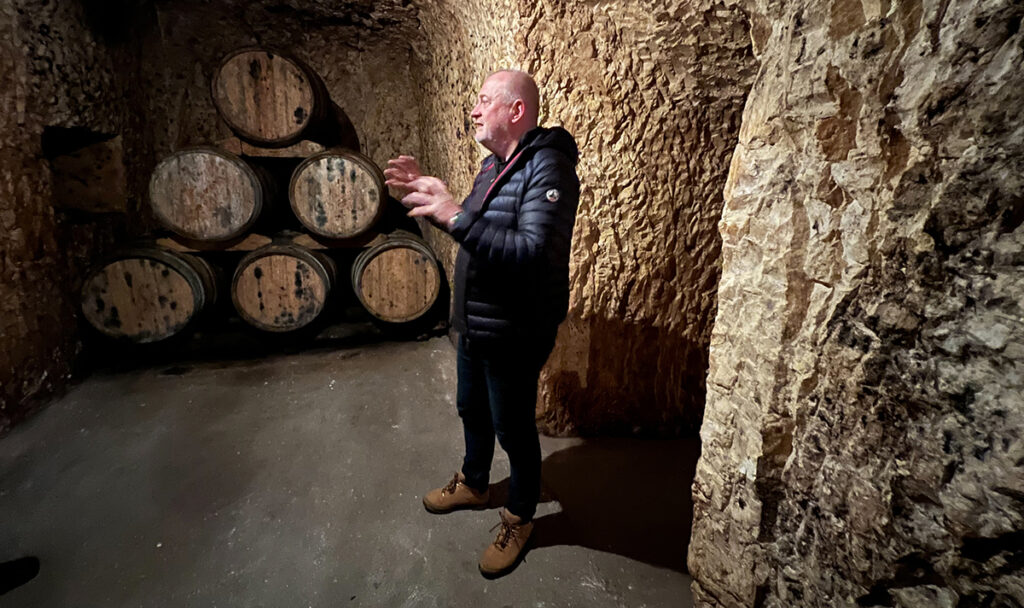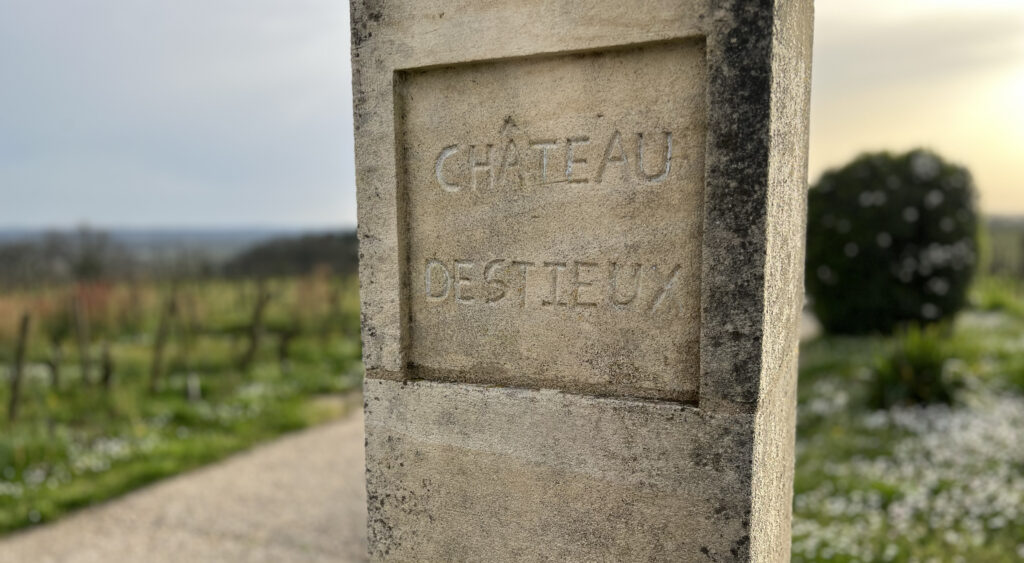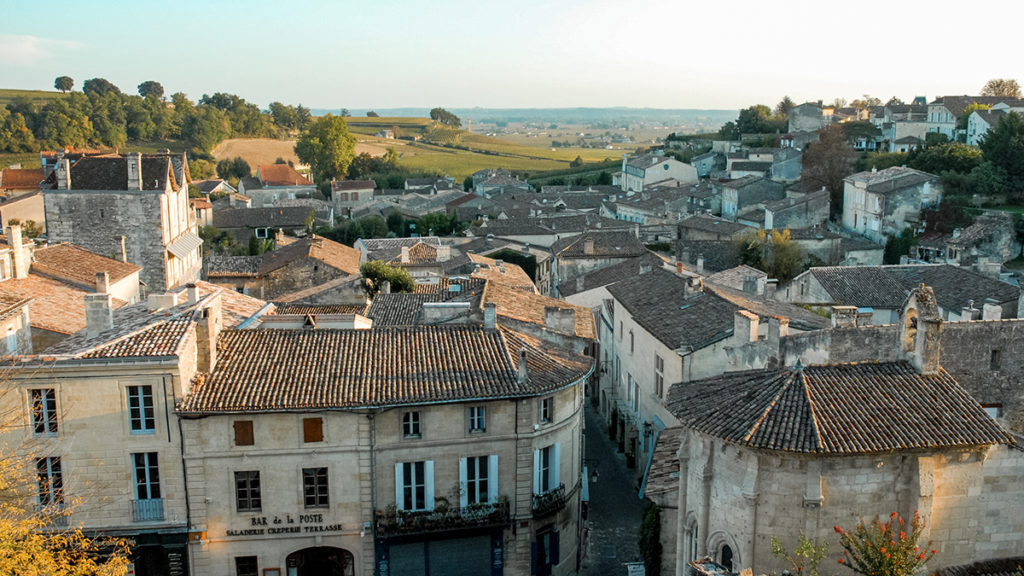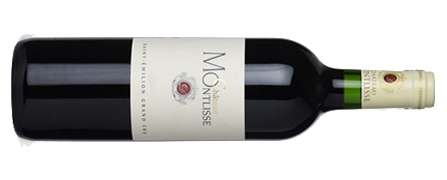Burgundy’s vignerons escaped frost damage this year, but since then they have been coping with an unusually rainy spring and early summer. “Time to build an ark,” William Kelley joked. Rain means a lot more work in the vineyard, but that’s a lot easier to take when you are in the midst of selling the excellent, plentiful 2022s. We are delighted to be there too, with this Futures offering featuring five exciting Burgundy sources: two Côte d’Or (Couvent’s 2022 reds, and Bohrmann’s 2022 whites), a Côte Chalonnaise (Desvignes 2022 reds), one Maconnais (Giroux 2020-2022 whites), and a collection of delicious and well-priced Beaujolais. In addition to the wines from Burgundy, this offering includes wine from St. Emilion and Pomerol from Bordeaux, Pouilly Fumé from the Loire, Cornas from the Northern Rhône, Châteauneuf du Pape from the Southern Rhône, and Grand Cru Champagne from the Côte des Blancs. As always, our goal is to propose wines for every taste and budget, and we hope you’ll find something of interest in this offering’s wide range of geography and prices. If you do, please be sure to submit your orders, in case or half-case lots, by the Order Deadline of Sunday, July 21, 2024. We will place orders for the wine immediately thereafter. We expect these wines to arrive in September/October 2024. Note that for high-end bottles we’ve reduced the minimum purchase to from 6 to 3. JUMP TO SECTION
Couvent
Bohrmann
Desvignes
Giroux
Beaujolais
Dumien-Serrette
André
Michot
Lancelot-Royer
Dauriac
July Futures
Order Deadline: 7/21
Domaine du Couvent
Gevrey-Chambertin, Burgundy
The wines of the 2022 vintage confirm what we have suspected for some time now – that the arrival of Phlippe Cheron as the winemaker at the former Domaine des Varoilles brought a notable step up in the winemaking. His 2022s show a deft hand across the board, both for the wonderful terroir of the former Varoilles properties and for fine family vineyards he brought to his newly named Domaine du Couvent. Cheron’s base cuvée, the Bourgogne Côte d’or “Les Jumelles,” offers very good value. From vines in Gevrey, it offers a look at the bigger, richer character that is the town’s signature. In 2022 it was vinified 100% from whole clusters, adding definition to the ripe, dark pinot fruit. It well overperforms its regional-level billing, and it has quickly become one of our favorite Bourgogne rouge cuvées. Burghound praised its “racy, delicious, and well detailed flavors,” and we think it will offer very good early drinking. The wine from the Clos du Couvent, the village-level Gevrey-Chambertin monopole from which the Domaine takes its name, is excellent in 2022. Jasper Morris MW found “clean raspberry-cherry fruit, medium bodied, rather stylish,” and Burghound praised its “pretty red and blue pinot fruit, soft spice, and prominent earth influence.” We think that the medium body includes plenty of intensity, and that the wine will retain its attractiveness as it ages over the coming 5 to 8 years. Among the excellent properties Cheron brought to his domaine are a village level Chambolle-Musigny from Clos de l’Orme. Cheron notes that the plot makes wines of more density than his other Chambolle blend, which gave him the scope to vinify 50% from whole clusters. This is big wine as Chambolle goes, tucking a bit of Gevrey-like power into the mix alongside the signature Chambolle elegance. Morris found it “lovely, suave and delicious,” awarding 90-93 points. Cheron has an impressive collection of premier crus, some from his family plots and others from the Varoilles holdings. Our three favorites this year come from three towns: Nuits-St-Georges, Gevrey-Chambertin, and Chambolle-Musigny. “Aux Murgers” Nuits St. Georges premier cru is from 80 year old vines in a parcel Cheron’s grandfather bought in 1938. This is a highly concentrated wine, vinified from 100% whole clusters. Cheron described it to us as “dark, somber, and rich,” and it is all that and much more. Morris found it “densely perfumed with black fruit and white pepper,” with a “gorgeously sensual middle” and a “very long persistent finish.” He thought it might ultimately merit 95 points. Burghound praised its “spicy aromas of black pinot fruit, earth and spiced game nuances.” This is dense and sleek; the rich stem-fermented core is entirely enveloped in deep inky fruit. We think it will readily find a place in any cellar featuring top-flight red Burgundy. We have always been partial to the former Varoilles monopole Gevrey-Chambertin premier cru “La Romanée,” a small strip of vineyard located just above the huge Clos des Varoilles (sold off to facilitate the integration of the Domaine du Couvent). La Romanée finds bedrock quickly below its shallow surface soils, and this makes for elegant, long-lived bottles. In 2022 it has a beautifully expressive nose supported by well rounded tannins. Morris called it “lifted and charming, not especially Gevrey in character, tasting more like a Chambolle-Vosne mix.” There is truth in this, and that may be why we love the wine so much: beautiful fruit, superb length, and the promise of a long life. This is indeed a special plot with a marriage of terroir elements we’ve yet to find elsewhere in Burgundy. Finally, Cheron’s personal favorite: Chambolle-Musigny 1er “Les Fuesselotes.” He acquired his vines here recently, in a trade for some precious rows of his outstanding Charmes-Chambertin Grand Cru. We scratched our heads a bit over the decision until we had our first taste of his Feusselotes. It is indeed Chambolle in character, but with an inky density that belongs in a class with Grand Crus. Burghound found “wood spice, just-crushed plum, violet and ripe black cherry,” and praised its “impeccably balanced finale.” This wine will definitely need time to develop, but should be something really special when it does. It’s an embarrassment of riches, but Cheron also makes two excellent Grand Cru reds. Cheron has a substantial family holding in Clos Vougeot. It’s a sentimental plot for him, and he waxes poetic about enjoying bottles from these vines with his grandfather in his youth. Here Morris found “a stylish nose, with depth and some dark red fruit character.” He thought this wine might merit 96 points, and given the firmness of its tannins, he prescribed “quite a while in bottle.” Burghound found that a “more elegant, even perfumed nose is comprised by airy and cool aromas of both red and dark pinot fruit that is laced with hints of kirsch, violet, earth and a whisper of wood.” We always enjoy this cuvée, and this 2022 is a triumph – given time this will be a special bottle. Cheron also has almost an acre in Mazoyères,” a climat in Charmes-Chambertin. (The wine may be labeled either “Mazoyères Grand Cru” or “Charmes-Chambertin Grand Cru” at the producer’s election. Jasper Morris described it as having “immediate weight à la Charmes, but with a density and minerality which is more Mazoyeres”). Morris found “an enormous volume of fine dark fruit here,” praising its “excellent concentration” and its “long and sensual finish.” We found it beautiful, with dark briary blackberry fruit mixing with gingerbread and warm earth. We think Morris’s 95-97 rating is well deserved. If you have the budget and patience, this will be magnificent. Finally, Cheron has set aside for us the last few cases of his exceptional Vosne-Romanée from 2020. This is a special plot – “Barreaux” lies near the top of the golden slope and faces north; and its higher elevation (plus a northern exposure along part of its flank) adds an attractive element of freshness to the rich fruit. Nor are its immediate neighbors exactly chumps; they include Richebourg Grand Cru, the superb Vosne premier cru “Aux Brûlées,” and the famous monopole “Cros Parantoux.” The wine itself is remarkable, and particularly successful in 2020 – the blazing hot and dry vintage verged on over-ripeness in sunny spots, but the exposition of this unusual plot resulted in perfect balance. As any readers who bought this two years ago will tell you, this is special wine – but you can also take Morris’s word for it. Jasper awarded 5 stars, finding “superb length,” and concluding “really quite a striking Vosne-Romanée.”
COUVENT Bourgogne rouge 2022: $395 Gevrey-Chambertin “Clos du Couvent” 2022: $795 *Nuits-St-Georges 1er “Aux Murgers” 2022: $1,095 *Clos de Vougeot Grand Cru 2022: $2,495 Vosne-Romanée “Barreaux” 2020: $1,095
(case prices)
Chambolle-Musigny “Clos de l’Orme” 2022: $995
*Gevrey-Chambertin 1er “Romanée” 2022: $1,295
*Chambolle-Musigny 1er “Fuesselottes” 2022: $1,395
*Charmes-Chambertin Grand Cru 2022: $2,595
*(wines marked with asterisks are available by the quarter case)
Domaine Bohrmann
Meursault, Burgundy
Those who saw last Sunday’s introductory post know that with the 2022 vintage, Sofie Bohrmann has once again turned out an excellent Bourgogne Côte d’Or blanc at a remarkably good price. From vines in Meursault, the body and aromas of “Belles Gouttes” 2022 bear a kinship with the famous wines bearing that village’s name. It is round yet fresh, with just a dollop of wood influence. We always keep some around at our homes, and you should consider doing the same. Wine lovers who follow the great white Burgundies of the Côte de Beaune have long looked to the side valleys – one coming in between Chassagne and Puligny, and another between Meursault and Volnay – for quality at good prices. As she assembled her domaine, Sofie found plots to buy in both. The word is out about the quality of St. Aubin (up the valley between Chassagne and Puligny), but the other valley – through Auxey Duresses to St. Romain – is still not as widely known. Perched at the very top of the hill, with a tonnellerie and the ruins of an old chateau, St. Romain offers some of the prettiest views in the Côte d’Or. Sofie Bohrmann acquired the Clos Sous le Chateau, a small monopole below the ruins. Particularly as a warming world benefits the higher elevations, it has proven to be a good choice. The 2022 vintage shows why: it is ripe but also lively, the result of its elevation. Its fruit mingles well with its oak, and with a futures price in the mid-thirties, it’s a steal. For even more richness and complexity, consider the 2022 Meursault “Clos du Cromin.” This bottle is real Meursault, offering plenty of body, unctuous and round, with excellent length on the palate and nicely integrated oak. This wine comes from a small plot – just about an acre – that lies near the town. It is classic Meursault: generous and rich, with complex aromas and fine concentration and density. The oak is limited, and Meursault’s signature vibrant, opulent fruit shines through. In the same category but at the Puligny-Montrachet premier cru level, there is a small quantity of Puligny “la Garenne” 1er cru 2022. The Garenne vineyard (pictured above) is near the very top of the appellation, above Champ Gain. Puligny’s calling card is a chiseled angularity that sets it up well for aging; but this wine has enough premier cru level richness to merit early drinking. The stony concentration in this wine is extraordinary – chalk and savory white pepper mix with with notes of apple crisp and gardenia. This is high class white Burgundy, and one that would be hard to top in a lineup of its peers. Finally, we recommend the Domaine’s Bourgogne Côte d’Or rouge “Entrecoeur.” It comes from old vines in Pommard, and so brings a dark color and concentration not often found in wine at this level. The 2022 is nicely ripe and particularly well-balanced. It seems even closer to village level than to other regional offerings from the area. 
Over in the other valley, there are two excellent choices from St. Aubin. First, at the village level, there’s a plot in St. Aubin’s “Champ Tirant” that was replanted in 2016 and came into production in 2020. There’s plenty of gras (fat) in this wine, but there is also good supporting freshness. Expect it to be attractive from the time it arrives, and to round out and integrate more fully over the coming year. Secondly, from the much-praised “Le Puits” vineyard, there’s a St. Aubin premier cru. This wine offers more density and concentration, with premier cru length on the palate. It is superb this year, a remarkable value – look for notes of lime zest and stones, with golden intensity and perfect balance. There’s elegance and subtlety here – match the wine with a dinner featuring elegant and subtle dishes.
BOHRMANN Bourgogne blanc 2022: $350 St-Romain “Sous le Chateau” 2022: $425 Bourgogne rouge 2022: $395
(case prices)
St-Aubin “Champ Tirant” 2022: $495
St-Aubin 1er “Le Puits” 2022: $695
Meursault “Clos du Cromin” 2022: $795
*Puligny-Montrachet 1er “Garenne” 2022: $1,195
*(wines marked with asterisks are available by the quarter case)
Domaine Desvignes
Givry, Burgundy
Regular readers will know Gautier Desvignes, the humble, friendly, thirtysomething winemaker who has transformed his modest family domaine into a top name in the region. William Kelley writes that Desvignes is “one of the leading lights in the Côte Chalonnaise,” and we wholeheartedly agree. Gautier’s 2022s show a talented winemaker firing on all cylinders. He has refined his cellar technique considerably, using gentler extractions, and focused his barrel work through exhaustive (some might say obsessive) experimentation and tasting. The resulting wines easily rival reds from the Côte d’Or in detail and complexity, and simply blow them away on price. Gautier’s village level Givry “Champ la Dame” is an astonishing value under $30. The 2022 is a punchy, characterful, flat out delicious red Burgundy, from entirely destemmed fruit. It bursts with dark Pinot fruit, friendly tannins, and a sturdy core. At 13.5% alcohol this has modern character and an old-school feel: ripe fruit from a sunny vintage, but with understated detail and crisp, vibrant texture. This is an easy candidate for an everyday house red Burgundy. At the premier cru level, Desvignes offers three distinct cuvées – Grand Berge, Clos Charlé, and Clos du Vernoy. All three are excellent in 2022, and while they offer enticingly approachable profiles in the palates are serious and sophisticated – we expect these to age beautifully for several years. Patience isn’t required, and a carafe will knock them awake with ease this fall, but with a year or two of cellaring we think these will be magnificent. The Grand Berge vines lie just in back of the domaine, and this is often the friendliest of the Desvignes premier crus. The 2022 is lovely – dark and floral with a dose of toast and a rich, jammy complexion. Look for raspberry and violets, and a clean medium weight finish. Serve this with a mushroom risotto this fall. Givry 1er cru “Clos Charlé” is finer – higher toned and with more chiseled detail. It’s particularly good in 2022, and easily worth twice the $3 upgrade from the village. The nose shows peony, wild cherries, and a delicate stoniness. The mouth is darker but retains a vibrant minerality alongside the inky fruit. Serve with a fine roast chicken. Finally Clos du Vernoy, the family’s monopole. This wine blew us away this year, and we’ve reserved as much as they’ll give us. It’s plump and delicious, with the juiciness of the Grand Berge and the finesse of the Clos Charlé. The nose is prototypical red Burgundy, showing spice, fruit, earth and toast, all in perfect harmony. The 60+ year old vines produce excellent concentration, and the wine shows a remarkable range of complexity. We think this would give a village-level Pommard a run for its money, and have high hopes for a long and fruitful life from this wine. As Gautier’s white vines become old enough to produce quality fruit, his Givry blanc cuvées are better and more available. He’s offered us two this year: one village, and one premier cru. The village level “En Cheneves” is crisp and precise with a lovely mix of stones and yellow fruit. It’s 90% Chardonnay with 10% Pinot Blanc, a combination that gives beautiful aromatics with classy and concentrated texture. It’s light on oak, and mostly about ripe springtime fruit – easy and friendly, we just wish there were more of it. Gautier’s premier cru blanc “Grand Vignes” is much more serious, but no less successful. The nose is savory and dense, with white flowers and herbs. Gautier uses 20% new oak for this wine, and its concentrated core supports the wood beautifully. There’s terrific tension in the mouth – it’s long, vibrant, and channeled, rather than opulent and rich. And with Givry instead of Puligny on the label, it’s a steal.
Domaine Giroux
Pouilly-Fuissé, Burgundy
For more than a decade we bought our Pouilly-Fuissé from Michel Forest in Vergisson, a soft spoken and humble man whose wines, tasted blind, were more than once judged by top sommeliers to be premier cru from the Côte d’Or. After his retirement we spent years looking for a suitable replacement, and then out of the blue we found two producers worthy of our clients’ attention. May’s Futures offering featured wine from one of them, Pierre Vessigaud of Pouilly, and today’s offering has wine from Sebastien Giroux of Fuissé, a young winemaker whose care and dedication to quality also achieves impressive results. Giroux’s entry level wine is Macon-Fuissé, from the “Vers Chanes” vineyard on the hill just above Fuissé. It is raised entirely en cuve, without oak influence. In 2022 there is fine volume and length, with freshness coming in at the end. As the wine opens in the glass, the fruit is pure Chardonnay, nicely ripe and clean. It’s a wine priced to drink often, and will please either on its own or with a meal. Loché borders Fuissé on the east, and though vines have been grown there since Roman times (excavation for the town’s TGV station unearthed a Roman villa) and more recently been tended by Benedictine monks, it is in the shadow, literally and figuratively, of Fuissé, its immediate neighbor to the west. Sebastien Giroux has two parcels there. We imported the 2020 vintage of his regular cuvée of Pouilly-Loché last year, and its combination of quality and price made it exceedingly popular, selling out in a short period. We have learned that there are a few bottles left at the domaine from that vintage, so by popular demand we are offering it again. Sebastien’s other parcel, from 70 year old vines in the “Au Bucher” lieu dit, is even more impressive. The 2020 vintage spent a year in 40% new oak, followed by 18 months’ elevage en cuve. The wine has a certain lacey delicacy, with a touch of salinity and a note of lemon peel. It is of medium weight – a wine of finesse rather than power – and we think that the many fans of the regular cuvée will be impressed with this wine as well. In Pouilly-Fuissé Giroux has an excellent parcel in “Les Raidillons.” The 2021 vintage had very low yields here as elsewhere, as well as fewer sunny hot days. But as always Sebastien took his time with it – giving it 12 months in large (400L) barrels – and it rounded out nicely. The wine shows the vintage’s freshness, but also impressive length and depth. In the end it’s an aromatically expressive wine with just enough gras. Here is a very successful wine that has benefited greatly from the winemaker’s skill. Finally there’s a very few cases of Giroux’s terrific premier cru “Vignes Blanches” from the 2020 vintage. It is just lovely, a big wine with all sorts of richness and length. It balances long, luxurious fruit with a finely chiseled structure in a way that calls to mind Puligny-Montrachet. Kelley gave 93+ points, finding it “wafting from the glass with scents of crisp yellow orchard fruit, freshly baked bread, vanilla pod, fresh mint and classy new oak.” He praised it as “full-bodied, ample and satiny, with racy acids, chalky structure and a penetrating finish.” The appellation has been twenty years coming up with a list of wines to award the premier cru designation, and this wine certainly belongs in the group.
Berne & Dupré-Goujon
Beaujolais, Burgundy
There’s no more exciting corner of Burgundy today than the Beaujolais. Long derided as a source for inexpensive plonk, the wines made here today are as dynamic and delicious as anything in the Côte d’Or – and at a fraction of the price. Wine writer Stuart Piggott calls Beaujolais “the best value reds in the world,” and it’s easy to see why. A new wave of exciting winemakers priced out of the land market in the north of Burgundy has landed in the Beaujolais; and while we’re sure they’d make tasty wine in Beaune, they’re more than succeeding in Brouilly. Our two vignerons here perfectly represent the region: young, energetic, innovative, and committed to low-intervention winemaking. Frederic Berne is a warm, friendly young winemaker in the town of Lantignié. His longterm goal is to add his home town as the 11th Cru Beaujolais, but whatever the outcome, along the way he continues to make terrific, classical Gamay. We have two selections from Fred this year, one simple, one serious. Berne’s Beaujolais-Lantignié “Pierre Bleue” 2023 is crisp, juicy, carefree and delicious – a Beaujolais for a backyard barbeque or a tailgate. Grown on the appellation’s blue granite soil, it’s lively and floral with low tannins and an easy, refreshing finish. Berne’s 2022 Chiroubles is more substantial and more serious, but still a bargain. The appellation’s signature deep rose petal nose is there, joined by a burst of wild cherry and a zip of stony minerals. This cuvée benefits from the hot dry vintage, combining ripe fruit and refreshing granite into a tasty package. FIfteen minutes further south in Côte de Brouilly appellation we find the Domaine Dupré-Goujon, quietly becoming a leading domaine in the Beaujolais. Winemaker Sebastien Dupré and Guillaume Goujon are crafting outstanding wines that elevate the potential of the gamay grape. We’ve gotten emails from customers with comments like “had no idea Beaujolais could be that good,” and “best Gamay I’ve ever had, by a lot.” We agree, and often find ourselves reaching for these vibrant organic wines. Part of the Dupré-Goujon recipe is an extended elevage (for their reds) of over two years, first in barrels, and then in tanks. This is nearly unheard-of patience in the Beaujolais, but one that turns out exceptional wines. We have two reds and one white to offer this year. Dupre-Goujon’s Côte de Brouilly “Pavé” cuvée is from 60 year old gamay vines, and the intensity from the aged vines is evident. The nose on the 2021 is deep and floral, with beautiful violet perfume; the mouth is at once chiseled and juicy, with a savory profile joining the brairy dark fruits. The tannins are fine and papery, a perfect structure for the classy fruit. Given the density we wouldn’t hesitate to age this 5-8 years, but with a carafe and plate of grilled meats it will be a hit this fall. Dupre-Goujon’s Côte de Brouilly “Heronde” is their top wine (and the one we get all those emails about). The 2021 is magnificent – deep and perfumed but remarkably light on its feet. Writing for James Suckling’s review, Spigott gave 96 points, calling it “a truly astonishing wine…stunning concentration…explosive stony minerality.” The tannins are exceptionally fine, supporting deep floral notes of peony and roses. We think the complexity here rivals many wines at twice the price from the Côte d’Or, and indeed the subtlety and elegance calls to mind a Volnay made from Gamay. If you’ve got a taste for Gamay, this is simply as good as it gets; and if you’re a doubter with room for a sub-$30 experiment, we bet you’ll be surprised.
Finally, Dupré-Goujon’s delightful Beaujolais blanc called “Clos des Muriers.” It’s pure chardonnay grown at the southern end of the Beaujoalis. We’ve long enjoyed this wine at tastings, but have never received an allocation until now. Raised for a year in 600L barrels, this is simply beautiful white Burgundy – a bit like a low-intervention Maconnais white but with more minerality. The nose shows apricots and fresh herbs, while the mouth is long, lush, and silky, balanced with beautiful chalky freshness. Spigott writes: “This could well be the best dry white wine made so far in Beaujolais.” He’s tasted far more than we have, so we’ll take his word for it.
Dumien-Serrette
Cornas, Northern Rhône Valley
Cornas is a tiny appellation. It covers 145 hectares (compared with Châteauneuf-du-Pape’s 3,000+), and is home to fewer than 50 vignerons. The name comes from the Celtic word for “burnt earth,” and it’s an appropriate moniker: Cornas is pure Syrah like the rest of the Northern Rhône, but the feel is of something sunnier from further South. Today fifth generation winemaker Nicolas Serrette farms a miniscule 1.8 hectares (4 acres) in Cornas. Simon Field MW of Berry Brothers writes of the Dumien-Serrette wines’ “granitic splendor” and “beguiling floral elegance which sets them apart.” Their old vines produce intense, teeth-staining Syrah, with extraordinary depth but remarkable freshness. Their primary cuvée is called “Patou,” made from 80+ year old syrah vines – and that’s their “young vine” bottling. The 2022 is terrific, a symphony of spice and deep black fruit. At 13% alcohol it’s sunny and ripe without an ounce of heaviness, the calling card of top Northern Rhône reds. The nose is deep and perfumed with notes of dark cherry, spices, cocoa and cured meats. The mouth is dark and rich but with sturdy tannin and a pleasant savory element. Vinous’s reviewer writes: “an intense Cornas framed by boatloads of ripe tannins, with secure aging potential.” We agree and consider this a prime candidate for 5-8 year aging. Serrette’s top cuvée is “Henri,” drawn from vines planted in 1913, and named for his grandfather, who was born that year. This is made with all whole clusters, and limited to around 50 cases a vintage. It’s got everything the Patou has, but with more depth and more length, and a bit more sweetness of fruit. This will require (rather than just benefit from) time in the cellar, but should handsomely reward patience. We put it in the same class as premier crus from top Burgundy producers, or Left Bank Bordeaux from a top chateau. Don’t let the sub-$70 price fool you – with time this could be one of the most impressive wines you buy all year.
Domaine Pierre André
Châteauneuf-du-Pape, Rhône Valley
Jon Bonné in his seminal book The New French Wine writes “Jacqueline André has quietly been upholding the extraordinary quality of her family’s domaine… The wines, too, are about old-fashioned subtlety: whole clusters, light extraction from pumpovers, mostly concrete vats for aging, and always at least 80 percent grenache.” André is fully worthy of this praise, and it’s never been clearer than today. Truly great winemakers show their greatness most clearly in difficult vintages, and Jacqueline André’s 2021 results put her in that class. The 2021 growing season brought challenges of biblical proportions, with damaging frost and hail in April, followed by serial heat waves, followed by late season rains. All of this dramatically reduced yields and threw off harvest schedules. The season required an adjustment in expectations, particularly after a couple of very warm, high-yielding vintages in which the struggle was against having too much alcohol and too much extraction. Despite the challenges of 2021, Jacqueline André made an elegant and absolutely delicious wine. Consonant with the dictates of the year, her Chateauneuf du Pape rouge 2021 is a wine of medium weight and mild tannins rather than huge density. Grenache always dominates the fruit in her wine, but in 2021 the distinct aromas of dried rose petals join the usual sweet wild strawberries to produce a refined and elegant glass of wine that is strikingly good. Nor will it be necessary to wait for winter or for evolution to enjoy this wine, which shows plenty of freshness and is drinking beautifully from the get go. We will be opening André Chateauneuf du Pape 2021 in spring, summer, and fall as well as in the depths of winter. It is that elegant and that versatile.
Frederic Michot
Pouilly-Fumé, Loire Valley
Pouilly-Fumé is the less famous neighbor of Sancerre, located just across the Loire River. The grapes here are Sauvignon blanc, and there’s a high percentage of flint in the soil, which gives the wines their eponymous “smoky” (Fumé) character. Our producer here is Frederic Michot, a brisk and energetic vigneron who makes wines that mirror his personality. They’re no-oak, no-nonsense, delicious and refreshing – and extremely well priced under $20. The 2023s are delicious this year, and as usual we’re offering both cuvées. The Pouilly-Fumé 2023 is lively and delicious. The nose shows grapefruit, a hint of herbs, and a burst of stoniness. The mouth is savory and punchy with a quick, clean mouthfeel and notes of grape skin and lemon zest. Serve with fish, oysters, cheese and crackers, or nothing at all. The old-vine “Cuvée Sainte Clara” is particularly good this year, with noticeably more concentration and length. It maintains the zip of the regular cuvée, but with more flesh on the bones. The nose is a beautiful array of spring flowers, grapefruit zest, and chalky stones. The mouth is smooth and delicious – refreshing and clean but with added savory complexity. It’s the classiest this cuvée has ever been, and we think it will make many friends.
Lancelot-Royer
Cramant, Côtes des Blancs, Champagne
The Chauvet family are winemakers at the Domaine Lancelot-Royer, a tiny Champagne house in Cramant in the heart of the Côtes des Blancs. All of their wines come from grapes they grow themselves, and their vineyards are 100% Chardonnay from exclusively Grand Cru plots. Everything here is done by hand, from harvesting and riddling to disgorging, dosing and labeling. The family’s cellars (see photo above) are a remarkable maze of caves carved into the moist chalk soil. Chauvet told us that whatever the temperature outside – 95° or 15°F – the conditions in the cellar remain 50° with 50% humidity. A visitor from 1922 would recognize just about every part of the Lancelot-Royer operation today. We have two cuvées to suggest this year, both providing excellent value and seriously classy winemaking. Americans are still a bit reticent about opening Champagne (something the Brits and the French got over centuries ago), but we always encourage our readers to use it in place of a white wine. Champagne is an exceptionally versatile food-pairing wine, and most people are familiar with how well it drinks on its own. A $5 stopper will keep it sparkling for a day or so; but if you’ve got more than two people over for dinner, one bottle probably isn’t even enough. In short, don’t limit yourself to celebrations. Lancelot-Royer’s “Cuvée des Chevaliers” Brut NV is terrific and user-friendly. The base of this wine (around two thirds) is from the 2017 vintage, with the rest from barrels of reserved older wines. After five years on the lees this is rich and toasty, with a lovely nose of pear, apple and buttery croissants. The mouth is crisp and delicious with plenty of richness amid the energetic freshness. William Kelley awarded 90 points, finding “generous aromas…rich and fleshy, with an enveloping core of fruit.” Serve in place of a Sancerre or premier cru Chablis. Their “Dualissme” cuvée is also non-vintage (a blend of several years), but is Extra Brut instead of Brut and comes from 40 year old vines in the two famous towns of Chouilly and Avize. This cuvée is equal parts 2017 and 2015 base, with 15% coming from reserve barrels. With 5 years on the lees, this is prettier and more savory than the “Chevaliers” cuvée. There’s less dosage (4g instead of 9g) and the character is more serious. This wine shows spring flowers and lemon zest in the nose, with excellent tension and tons of length in the mouth. Serve in place of a Puligny-Montrachet.
Vignobles Dauriac
St-Emilion, Bordeaux
We have been buying wines from Christian Dauriac, the owner of three fine properties on Bordeaux’s right bank, for a quarter century. Over that time we have seen both Château Destieux and Château Montlisse elevated from St. Emilion Grand Cru to St. Emilion Grand Cru Classé. The winemaking has always been excellent, but recognition has arrived more slowly – Destieux was awarded “Grand Cru Classé” in 2006 and Montlisse just recently, in 2022. A word about the classification system in St. Emilion: While the various levels of Grand Cru Classé on the left bank all stem from a single classification in 1855, St. Emilion undertakes a review of its classified wines every ten years, in which wines can go up or down. In the reverse of Burgundy’s approach, where the Grand Cru designation is at the top and covers less than 5% of the wine, most of the classified wine in St. Emilion is rated simply “Grand Cru.” A limited number of Grand Crus earn the designation “Grand Cru Classé,” and only a handful become “Premier Grand Cru Classée.” For example, in the 2022 classification, there are more than 200 Grand Crus but only 71 entitled to the “Classée” designation and just 14 allowed to add the word “Premier.” Château Destieux is the flagship Dauriac property. It lies along the highest ridge in St. Emilion, and includes significant amounts of both Cabernet Franc and Cabernet Sauvignon along with the dominant grape, Merlot. When we visited in March, we found the 2019 vintage drinking particularly well. Its sweet, perfumed nose was open and expressive. It filled the mouth, but also showed excellent balance and length. This Destieux offers much enjoyment today, and we think it will continue to age very well from here. Reviewing the 2019, William Kelley awarded it “92+.” He wrote: “Offering up a rich bouquet of ripe berries, mint, vanilla pod and spices, the 2019 Destieux is a full-bodied, muscular wine with a dramatic core of fruit, ripe acids and plenty of ripe, powdery tannin.” Château Montlisse has always been priced well, and the 2019 Montlisse pricing is very attractive, particularly for a wine about to be promoted to Grand Cru Classé. The Wine Advocate’s Lisa Perotti Brown wrote this about it: “Medium to deep garnet-purple in color, the 2019 Montlisse opens with woody/cedary suggestions, giving way to a core of stewed plums, baked black cherries and mulberries plus wafts of chargrill and mocha.” Tasting it in March, we found the nose open and ripe, and the weight attractive. As with the Destieux, the weight and balance lead us to suggest the 2019 vintage over the very good 2020 that followed. Chateau La Clemence is in Pomerol, the tiny appellation whose wines are all or nearly all Merlot, and whose most celebrated wines command prices at the summit of Bordeaux pricing. Christian Dauriac purchased Clemence in 1996 at the suggestion of his consultant Michel Rolland. He built an entirely new chai and undertook to turn it into an “haute couture” wine, with sortings both in the vineyard and cellars, and vinification in micro-foudres, one for each of the different Pomerol terroirs of the estate. The goal is a smooth wine featuring all the richness that 85% Merlot can provide. Dauriac succeeded admirably in 2019. Today Clemence 2019 is delicious, offering a lovely mouthfeel with super-fine tannins and excellent length. Fans of Clemence and Pomerol will be very happy with this vintage.
_____________________________ We expect these wines in September/October 2024. If you have any trouble submitting the new order form, you can always email us your order. Or give us a call with questions: 617-249-3657, or tom@ansoniawines.com The deadline to place orders for this issue is: SUNDAY, JULY 21. Questions? Need advice? Call us: (617) 249-3657. OPTIONS FOR GETTING YOUR ORDERS Pick-up near Philadelphia. We’re pleased to restart our PA pickup option. Wines ordered for PA pickup will be available in the fall, depending on temperatures. Email us for more details. Shipping elsewhere. In most states we can arrange for shipping at an additional cost that varies by location ($3.50 per bottle to the addresses west of Chicago; $2.50 per bottle east of Chicago). If shipping interests you, let us know the state and we will figure out if it can be done.
Pick-up in Massachusetts. We store our inventory at our new warehouse in Newton: 12 Hawthorn St, Newton MA 02458. Futures customers can pick up their orders here during Saturday open hours, or by appointment.
